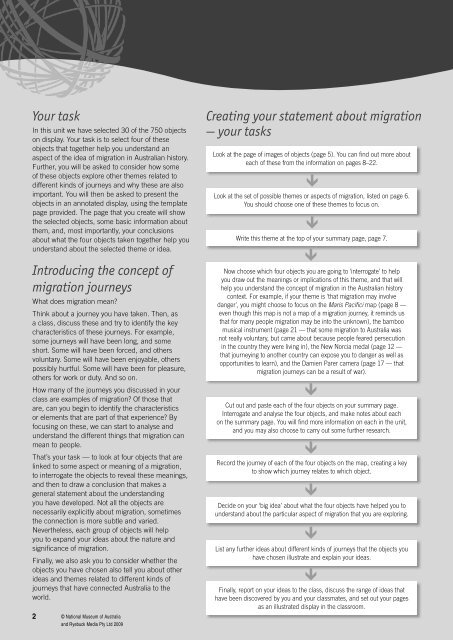Australian Journeys - National Museum of Australia
Australian Journeys - National Museum of Australia
Australian Journeys - National Museum of Australia
You also want an ePaper? Increase the reach of your titles
YUMPU automatically turns print PDFs into web optimized ePapers that Google loves.
Your task<br />
In this unit we have selected 30 <strong>of</strong> the 750 objects<br />
on display. Your task is to select four <strong>of</strong> these<br />
objects that together help you understand an<br />
aspect <strong>of</strong> the idea <strong>of</strong> migration in <strong><strong>Australia</strong>n</strong> history.<br />
Further, you will be asked to consider how some<br />
<strong>of</strong> these objects explore other themes related to<br />
different kinds <strong>of</strong> journeys and why these are also<br />
important. You will then be asked to present the<br />
objects in an annotated display, using the template<br />
page provided. The page that you create will show<br />
the selected objects, some basic information about<br />
them, and, most importantly, your conclusions<br />
about what the four objects taken together help you<br />
understand about the selected theme or idea.<br />
Introducing the concept <strong>of</strong><br />
migration journeys<br />
What does migration mean<br />
Think about a journey you have taken. Then, as<br />
a class, discuss these and try to identify the key<br />
characteristics <strong>of</strong> these journeys. For example,<br />
some journeys will have been long, and some<br />
short. Some will have been forced, and others<br />
voluntary. Some will have been enjoyable, others<br />
possibly hurtful. Some will have been for pleasure,<br />
others for work or duty. And so on.<br />
How many <strong>of</strong> the journeys you discussed in your<br />
class are examples <strong>of</strong> migration Of those that<br />
are, can you begin to identify the characteristics<br />
or elements that are part <strong>of</strong> that experience By<br />
focusing on these, we can start to analyse and<br />
understand the different things that migration can<br />
mean to people.<br />
That’s your task — to look at four objects that are<br />
linked to some aspect or meaning <strong>of</strong> a migration,<br />
to interrogate the objects to reveal these meanings,<br />
and then to draw a conclusion that makes a<br />
general statement about the understanding<br />
you have developed. Not all the objects are<br />
necessarily explicitly about migration, sometimes<br />
the connection is more subtle and varied.<br />
Nevertheless, each group <strong>of</strong> objects will help<br />
you to expand your ideas about the nature and<br />
signifi cance <strong>of</strong> migration.<br />
Finally, we also ask you to consider whether the<br />
objects you have chosen also tell you about other<br />
ideas and themes related to different kinds <strong>of</strong><br />
journeys that have connected <strong>Australia</strong> to the<br />
world.<br />
2 © <strong>National</strong> <strong>Museum</strong> <strong>of</strong> <strong>Australia</strong><br />
and Ryebuck Media Pty Ltd 2009<br />
Creating your statement about migration<br />
— your tasks<br />
Look at the page <strong>of</strong> images <strong>of</strong> objects (page 5). You can fi nd out more about<br />
each <strong>of</strong> these from the information on pages 8–22.<br />
Look at the set <strong>of</strong> possible themes or aspects <strong>of</strong> migration, listed on page 6.<br />
You should choose one <strong>of</strong> these themes to focus on.<br />
Write this theme at the top <strong>of</strong> your summary page, page 7.<br />
Now choose which four objects you are going to ‘interrogate’ to help<br />
you draw out the meanings or implications <strong>of</strong> this theme, and that will<br />
help you understand the concept <strong>of</strong> migration in the <strong><strong>Australia</strong>n</strong> history<br />
context. For example, if your theme is 'that migration may involve<br />
danger', you might choose to focus on the Maris Pacifi ci map (page 8 —<br />
even though this map is not a map <strong>of</strong> a migration journey, it reminds us<br />
that for many people migration may be into the unknown), the bamboo<br />
musical instrument (page 21 — that some migration to <strong>Australia</strong> was<br />
not really voluntary, but came about because people feared persecution<br />
in the country they were living in), the New Norcia medal (page 12 —<br />
that journeying to another country can expose you to danger as well as<br />
opportunities to learn), and the Damien Parer camera (page 17 — that<br />
migration journeys can be a result <strong>of</strong> war).<br />
Cut out and paste each <strong>of</strong> the four objects on your summary page.<br />
Interrogate and analyse the four objects, and make notes about each<br />
on the summary page. You will fi nd more information on each in the unit,<br />
and you may also choose to carry out some further research.<br />
Record the journey <strong>of</strong> each <strong>of</strong> the four objects on the map, creating a key<br />
to show which journey relates to which object.<br />
Decide on your ‘big idea’ about what the four objects have helped you to<br />
understand about the particular aspect <strong>of</strong> migration that you are exploring.<br />
List any further ideas about different kinds <strong>of</strong> journeys that the objects you<br />
have chosen illustrate and explain your ideas.<br />
Finally, report on your ideas to the class, discuss the range <strong>of</strong> ideas that<br />
have been discovered by you and your classmates, and set out your pages<br />
as an illustrated display in the classroom.

















